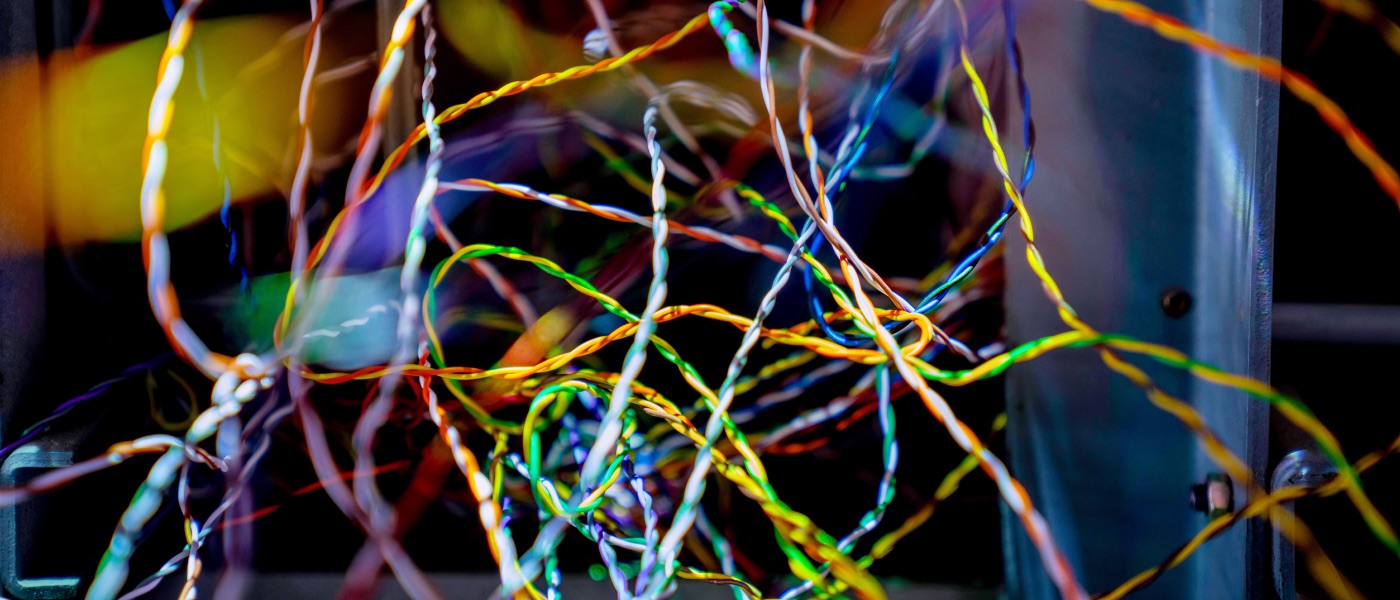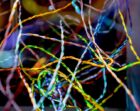
Gazes that communicate is an exhibition that forms part of Telefónica’s Centenary celebrations, paying tribute to the last hundred years of a fascinating history, a history characterised by the spectacular technological, cultural and social breakthroughs that have taken place in our country and, in turn, marked the company’s birth and consolidation.
Gazes that communicate is an exhibition that forms part of Telefónica’s Centenary celebrations, paying tribute to the last hundred years of a fascinating history, a history characterised by the spectacular technological, cultural and social breakthroughs that have taken place in our country and, in turn, marked the company’s birth and consolidation.
Photo Credit: Close look of Daniel Canogar’s piece ©VictoriaÁlvarez
Based on this narrative, the exhibition invites five Spanish creators to reinterpret Telefónica’s huge technological and audiovisual legacy, made up of more than 85,000 pieces. This has resulted is newly-created art installations addressed by their authors’ different disciplines and approaches, enhancing and giving a new meaning to these collections. In addition to the above, there is a sixth piece made in the 1970s that connects us with the telephone as an instrument of human communication.
The La Fura dels Baus drama company, visual artist Daniel Canogar, Cabosanroque, the experimental sound collective, filmmaker Nuria Giménez, multidisciplinary artist Eugènia Balcells and conceptual artist Isidoro Valcárcel Medina make up this renowned creative cast.
To aid the inspiration and conception of their pieces, Fundación Telefónica has opened the doors of its significant technological heritage, from whose collections the artists have chosen key objects in the history of telecommunications, such as various models of telephones, distributors and cables, as well as photographs and films from different periods that give rise to installations in which history and technology merge with the artistic possibilities of light, sound, colour and image.

EUGÈNIA BALCELLS
Eugènia Balcells is one of the pioneers of experimental cinema and audiovisual art in our country. She was born in Barcelona in 1941 into a family of architects and inventors, which influenced her early interest in perception and the balance between the tangible and intangible, the illusory and the exact. After graduating in Technical Architecture in 1968 and continuing her training in the United States, she began her artistic activity in the mid-1970s.
In her early work, imbued with conceptual art, she addressed themes related to contemporary consumer society. Later, through her contacts with different American musicians, she explored the relationship between image and sound, as well as the limits of visual perception. This physical and philosophical research led to her conception of installations featuring light, in which qualities and symbolisms that evoke the sciences, the arts and the humanities converge in a powerful appeal to the cross-disciplinary nature of knowledge.
Her work has been displayed at important exhibitions and it forms part of major collections, including those of the Reina Sofía National Art Museum and the MACBA in Barcelona. She has received awards such as the Gold Medal of Merit in the Fine Arts (2009) and the National Visual Arts Award of the Government of Catalonia (2010).

CABOSANROQUE
Cabosanroque is a sound art and experimental music collective formed by Laia Torrents Carulla and Roger Aixut Sampietro. Often in partnership with other artists and thinkers, they generate pieces combining visual arts, performing arts and music, offering new creative frameworks and spaces for reflection.
Their work is based on sound and its performative capacities, with interventions that defy conventional formats and spaces and actively engage the audience. The result is made up of experiences that explore physical, temporal, conceptual, sound-related and visual themes, using technology as the main tool in the creative process.
Recognised both at home and abroad, they’ve exhibited their works at important institutions, including CaixaFòrum, the Barcelona Centre of Contemporary Culture and the Georges Pompidou Centre, as well at events such as the Sónar and Grec festivals. Since 2015 they’ve been artists in residence at the Lluís Coromina Foundation, where they’re continuing to develop their particular creative approach.

DANIEL CANOGAR
Born in Madrid in 1964, Daniel Canogar’s life and career have been spent in Spain and the United States. Although photography was his first medium of choice, he soon became interested in the possibilities of the projected image, fibre optics and installation art. Since 2010, he’s worked on numerous occasions with obsolete technological objects, giving them a new life through digital means. The artist thus reflects on the cycles of creation and destruction that are intrinsic to consumer electronics, relating this phenomenon to the loss of both personal and collective memory.
His recent public art installations with LED screens include Pulsation at Nike’s global headquarters (Oregon, 2023), Brushstrokes at DeKa Bank’s head offices (Frankfurt, 2022) and Tendril at Tampa International Airport (2017). He has contributed to site-specific projects such as Dynamo at Expo 2020 Dubai and monumental public artworks such as Scrawl at the MNCARS (Madrid, 2023).
His numerous solo exhibitions also include At Any Given Hour at the Galerie Anita Beckers (Frankfurt, 2024), Pixelweaver at the Bitforms Gallery (New York, 2023) and Turbulencias at the Galería Max Estrella (Madrid, 2022). He’s exhibited his works at major museums and galleries around the world, including the MNCARS (Madrid), The Phillips Collection (Washington DC) and the ZKM Centre for Art and Media (Karlsruhe).

NÚRIA GIMÉNEZ
Nuria Giménez is a renowned Spanish filmmaker who was born in Barcelona in 1976. She studied Journalism, International Relations and Documentary Making and completed her training with seminars and workshops led by filmmakers such as Isaki Lacuesta, Andrés Duque, Virginia García del Pino and Sergei Dvortsevoy.
Her first feature film, My Mexican Bretzel, selected at events such as the San Sebastian and New York Film Festivals, received two Goya nominations and several prizes (three Gaudí awards, the Best Film at FICX19, the Audience Award at D’A’20, the IFFR20 Found Footage Award, etc.). The film came about as a result of her discovering family film footage in her grandparents’ home. Beyond faithfully reconstructing her family history, she set out to explore broader themes through a free interpretation of the images.
Her work has excelled in terms of its innovative and experimental approach to music and films, using archive material to create a narrative that defies traditional conventions, and it has led her to receive commissions from institutions such as Barcelona City Council, the Spanish Film Archive, La Virreina and the Barcelona Auditorium. Together with Miquel Martí Freixas, she co-directs the La Inesperada film festival held each year in February in Barcelona.

LA FURA DELS BAUS – Artistic director: Pep Gatell
Pep Gatell, co-founder and artistic director of La Fura dels Baus, has created more than 250 shows, integrating all kinds of technology into them, including synthesisers, CD-roms, websites, 3D stereoscopic images, mobile apps, etc. His constant interest in exploring new artistic formats has led him to collaborate with different multidisciplinary entities and research centres.
His most recent and widely-acclaimed projects include the release of M.U.R.S. in 2014, in which he developed an innovative platform for interactivity via a mobile application. He also co-directed the opening ceremony of the Youth Olympic Games in Nanjing and directed the one proclaiming Valletta as the European City of Culture in 2018. Finally, in 2022, he directed the interactive macro-spectacle titled En Un Lugar de Guanajuato at the 50th International Cervantino Festival in Mexico.
Since 2017, Gatell has presided over the Épica La Fura dels Baus Foundation, a research centre for advanced arts that promotes horizontal collaboration between art, science, technology and society. Within this context, he has worked in close cooperation with renowned research centres, including the Germans Trias i Pujol Research Institute, the Barcelona Institute of Science and Technology, the Institute of Neurosciences of the University of Barcelona and the Computer Vision Centre.

ISIDORO VALCÁRCEL MEDINA
Born in Murcia in 1937, Isidoro Valcárcel Medina is a leading Spanish conceptual artist and poet. He began his career as a painter under the influence of Informalism and later evolved towards constructivist and minimalist tendencies. Subsequently influenced by the Fluxus movement and conceptual art, he decided to move away from the conventionalisms of art and focus on the creative power of the intervention, the act, the scene. Based on this dynamic and liberating perspective, he questioned the limits of perception and communication and explored the intrinsic relationship between art and language. As a result of the above, his work was gradually stripped of superfluous materiality, reflecting the purity of his visual poetry and his famous “environments”.
Throughout his far-reaching career, Valcárcel Medina has taken part in exhibitions at Spanish galleries and museums, including the Antoni Tàpies Foundation in Barcelona (2022), the MACBA (2006) and the Reina Sofía National Art Museum (2009). He has also received important awards and recognition for his contribution to contemporary art, such as the National Award for Plastic Arts (2007) and the Gold Medal of Merit in the Fine Arts (2015). His legacy lives on today as a source of inspiration for future generations of artists and thinkers.




